The camera was a rather splendid-looking black-bodied SRT-303, looking regal in a camera bag that had been its home for the life it had with the previous owner. Fitted with an MC Rokkor PF 50mm F1.7 lens, the SRT-303 came with its own camera case almost in tatters.
Looking at its development, the SRT-303 was launched in 1973 as the premium flagship model of the SRT series. The model was marketed as the SRT-102 in the USA and Canada, and SRT-Super in Japan, later updated to SRT-202, SRT-303b, SR505, and SR505S./p>
The general model SRT-101 (1966), which was the original model for the series, continued to be sold alongside the SRT-303 and was later updated to SRT-201, SRT-101b, SR101, and SR101S. Budget models for the series include the SRT-100, SRT-200, SRT-100b, and SRT-100x.
Other models of the series include the SR-M, a motorized model, the SC/MC, and the MC-II/SC-II, sold as in-house models by department stores. The SRT series was in production from 1966 to 1980.
The Pride of Excellence
What sets the SRT series apart from the rest of the SLR camera manufacturers is the introduction of the open aperture TTL (Through the Lens) metering. With the system, exposure reading was done at full aperture, with the lens wide open, as against doing it with the lens stopped down, while looking through a viewfinder which is now dimmed.
On its own, improvements done to the SRT-303 over the original SRT-101 include a full information viewfinder with the addition of a small window on top of the screen to show lens aperture, a split image rangefinder as a new focusing aid on the focusing screen, multiple-exposure capability by pressing the rewind release button while priming the shutter release, and a hot shoe in place of the cold one.
Basic Camera Features
Solid and sure in the hand, the all-mechanical SRT-303 (except for the button cell to power the metering system), available in both silver and black, comes with a focal plane type shutter with a speed range from 1 to 1/1000 second, and a B, 10-second delay self-timer, with film ISO rating from 6-6400.
Unique to the SRT series is the almost identical look across the range of cameras produced. There are subtle changes, however. The SRT-303 is a later development and comes with a top plate that has a rounded front edge, different from the initial SRT-101, which has a stepped design.
The SRT-303 also has a new bulk added to the pentaprism that incorporates a direct read window to allow the f-stop to be displayed in the viewfinder. A hot shoe, now with a bakelite base, replaces the previous flash cold shoe, and the PC contact on the SRT-303 is now used for both the FP and the X connections, engaged via an FP or X selector switch.
The top plate is a familiar sight to SRT enthusiasts. To the left is the rewind crank coupled to the pull-up film back release, and the hot shoe on top of the pentaprism housing. On the right, the shutter speed dial, which is integrated with the pull-up and turn film ISO dial, the cable-threaded shutter release button sharing the same axis as the film forward crank, and the film frame window towards the right edge of the top plane.
On the back, a hinged film-back across the whole width of the camera back, and the viewfinder window is almost centrally to the backplane of the camera top. An ASA/DIN conversion dial is located centrally on the film back.
On the bottom plate, the film rewind release button, camera battery chamber with a knurled type cover, tripod socket, and the On/Off/Battery Check switch, again operated by pressing your thumb and knurling it to the setting you want to set.
The film box is the standard lining up the film end to engage the sprocket gear and inserting the end of the film tab into one of the tabs on the take-up spool before closing the back and doing the two-blank shots to move the film properly to frame 1.
To unload, press the film rewind release on the bottom plate of the camera and turn the film rewind crank clockwise until the film roll is completely rewound into the film canister.
Multiple Exposure Shots
On the SRT-303, one thing you might notice is that the film forward system is designed with a very tight tolerance. The take-up spool is tightly locked to prevent film slippage, even if the film rewind crank is accidentally turned or when you are setting the SRT-303 for multiple exposure shots.
To prepare the SRT-303 for multiple exposures, you need to press the film rewind release button and prime (advancing the film forward crank) the shutter simultaneously.
Viewfinder Readout
The viewfinder in the SRT-303 is a Matt-Fresnel-Field focusing screen with a 2.5mm diameter flat split-image spot surrounded by a microprism band.
The view is supplemented by a direct aperture readout window central on the upper part of the viewfinder screen, the shutter speed scale on the lower part, and the match needle exposure pointers on the right vertical of the viewfinder frame.
The straight needle is the aperture opening that corresponds to the aperture setting on the lens, while the balloon end is the shutter speed indicator. Aligning the two needles together can be done either by shutter or aperture priority exposure measurement.
The two pyramidal shapes flanking the needle movement indicate the limit of the exposure reading, and the square box is the needle rest point, showing sufficient battery power is available when doing a BC (Battery Check).
TTL Metering
Metering is always done at the full aperture by the TTL metering system on the SRT-303. Stop-down metering is available for non-MC or MD lenses or when the camera is fitted with a reverse ring setup or otherwise, where the auto aperture connection is disabled.
When used with MC or MD lenses, the stop-down mechanism of the camera is mainly used for DoF (Depth of Field) preview.
Battery
The SRT-303 requires a 1.35V mercury battery, an Eveready EPX-625, or equivalent. Since these batteries are not available anymore, I make do with a higher voltage (1.5V) LR or SR 44 cell and a stop reduction on the ISO film speed setting.
Dimension and Body Weight
The SRT-303 measures 145 x 47.5 x 85mm and weighs 710 grams without a battery.


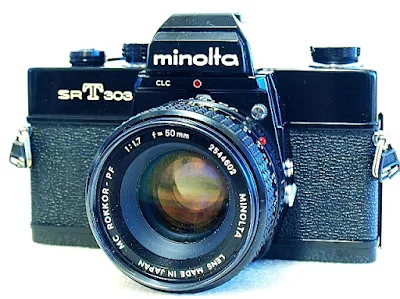
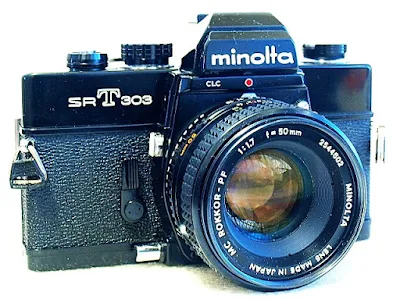

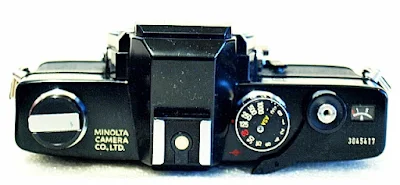
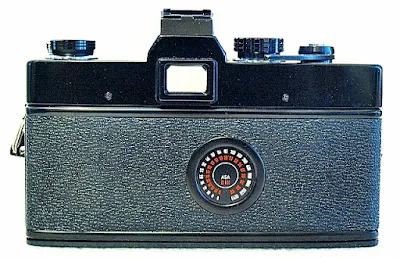
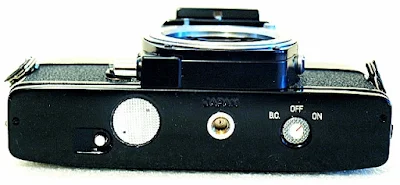

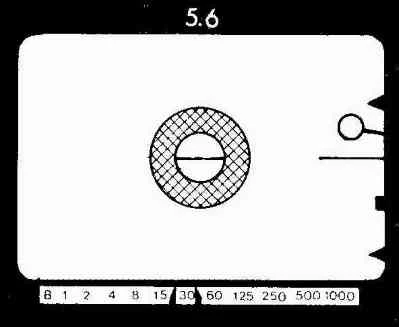










I have owned a Minolta SRT-101 (my first camera that I bought from K-Mart for $209 with an f1.7 50mm lens when I was 17 in 1973). Then after I lost my camera with its lenses (I put it on top of my car and I drove off), I purchased a new XD-11, then a used XD-7. I gave them to my sons later (they sold it! Augh!). Now I have a used Minolta XD-5. I want to get this SRT303.
ReplyDeleteJolly good idea, the Minolta SRT-303 (in Europe) is known as the SRT-102 in the USA, and SRT-Super in Asia-Pacific. All the best!
DeleteI thoroughly your write-up! Last year while on the hunt for a new camera, to complement my (now aging) DSLR an extremely good friend of mine informed me he found a camera (an SRT-303) in the backseat of his car, flash, lens(es) and all. He gave it to me, and after nearly a year of lying around I finally gave it a field run and it worked perfectly. It hadn't been used in ??? years. A testament to Japanese engineering methinks.
ReplyDeleteI purchased a SRT-303 in 1973, at the US Navy store in Naples, Italy. I was 17, had been assigned to the USS Little Rock, sixth fleet flagship home ported in Gaeta, Italy. That camera was a miracle, so many beatutiful shots taken all over Europe and north Africa. I still have it. The film advance doesnt work quite right and I could take it in to repair. Currently own a Sony A7iii.
ReplyDelete